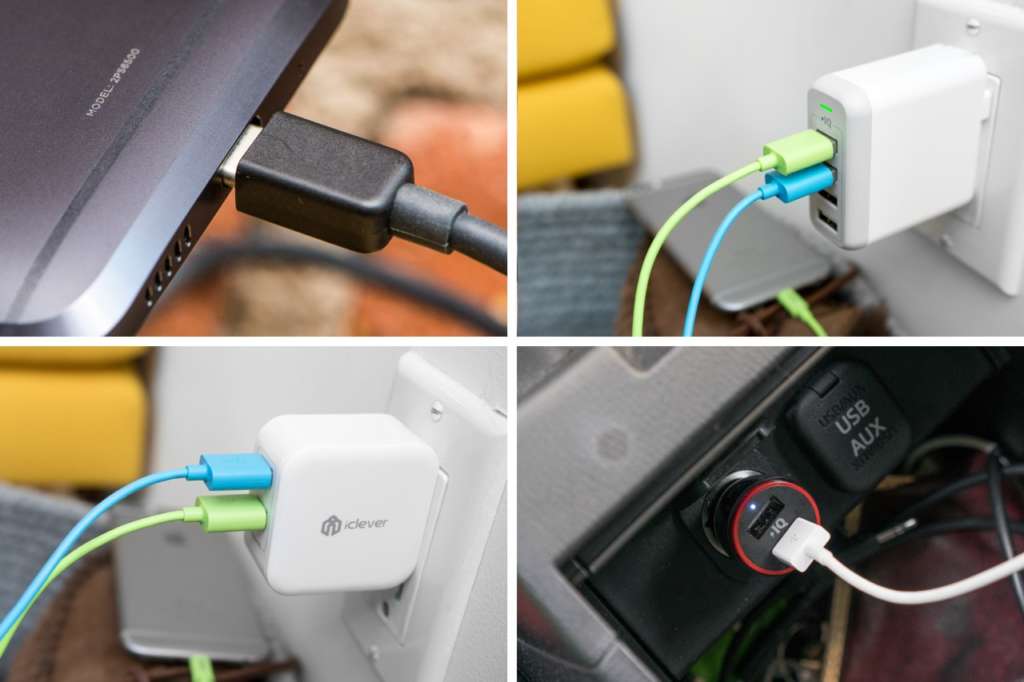We can’t live without our cellphones and they can’t live without battery power. So how best to keep them charged? Nick Guy, senior staff writer for The Wirecutter, The New York Times’s site that evaluates products, plugged the devices into chargers and came up with some answers.
When I type “wall charger” in Amazon, I get 32,819 results. Help me sort it out.
The huge number of options out there can seem overwhelming. But it’s not so bad once you know what to look for. Our top pick for a wall charger is Anker’s PowerPort 4. It has four USB ports, each of which can provide up to 2.4 amps per port. Most devices you own can’t draw more amperage than that, so this charger will charge most devices at top speed, including larger phones and tablets. The exceptions are newer devices compatible with USB-C PD and Qualcomm Quick Charge, but those technologies aren’t quite ubiquitous yet.
I lug my charger around. Could I carry it in my pocket? Would it weigh down a purse or bag?
The PowerPort 4 would fit in a bag, but it might be just a hair big for a pocket. We like iClever’s Dual USB Travel Wall Charger as a more portable option. It has only two ports, but it’s about an inch and a half square by just over an inch thick, so it’s pretty compact.
I recently read that public charging stations can be dangerous to use because they could suck down data. Is that a concern?
I don’t see it as a huge concern, but yes, it’s certainly possible for people to transfer information to or from your device from a public USB port. Having your own charger definitely eliminates this concern, because that information can’t travel over a power outlet alone.
And you get the added bonus of charging multiple devices at once without being that person at the airport hogging all the outlets.
I like that. What car chargers do you recommend?
Our pick is Anker’s PowerDrive 2, which has two high-speed 2.4-amp ports, and is only $10. There are actually a fair number of good chargers around that price, but we like Anker’s because of the company’s 18-month warranty and the little status light that lets you know when it is plugged all the way in.
You guys like a lot of Anker products. What about Amazon Basics or Monoprice?
Anker has really been knocking it out of the park for the past few years with powerful, well-designed stuff that’s really affordable.
Amazon Basics and Monoprice both tend to have good, inexpensive products as well, but when it comes to cables they are often, if not always, white-label products that the seller simply slaps its name on. We used to recommend Monoprice cables, but the models would change too frequently; you might order a cable one day and see a different design in the store the next.
You even have a recommendation for the cord that connects your charger to a device?
Yes! Again, we pick Anker here. Its PowerLine Lightning and Micro USB cables are strong, inexpensive, come in a number of lengths and colors and, once again, there’s that warranty.
Anyone who has ever had a busted cable will appreciate being able to get it swapped out without hassle.
I’ve used so much Sugru fixing those things.
I’ve seen plenty of that, and plenty of people who just let the exposed cabling show through. The strain relief — the part where the cable itself meets the plug end — on these cables is stronger than most. Anker says it can withstand up to 5,000 bends.
How do you test the chargers?
Thankfully all the testing has been straightforward. Plug it in and it charges at full speed or, rarely, it doesn’t. No sparks or smoke. Of course we take considerations such as port positions and overall design into account, too. A charger doesn’t need to be a design piece, but why settle for an ugly one?
What’s the strangest one you’ve seen?
There are a few clever car chargers that have charging units on the end of a long cable, so they can reach to the back seat and keep your passengers charged. I don’t have kids, but I imagine that could be superuseful for when they’re watching videos and playing games.
(The New York Times)
